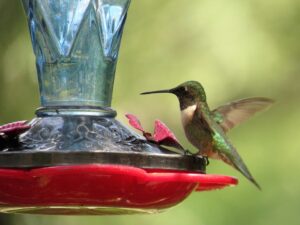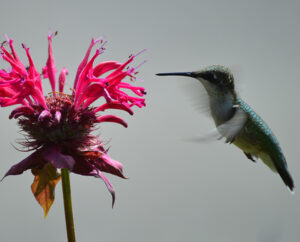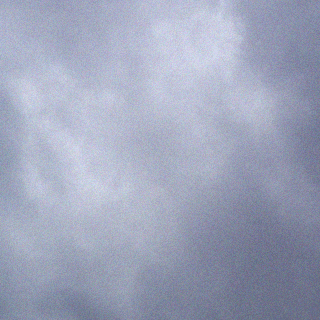Key Points from the Claim
-
Feeders with sugar water can harm hummingbirds, making them sick and disrupting pollination.

-
Feeders can cause fungal growth, which kills hummingbirds.
-
Natural flowers and water are better for hummingbirds.
What the Research Actually Shows
1. Sugar Water Feeders and Hummingbird Health
-
Sugar water feeders can harbor bacteria and fungi, but most microbes found in clean feeders are not known to cause disease.
-
The real risk comes from dirty feeders. If not cleaned regularly, harmful bacteria and fungi can grow, potentially causing infections that can be fatal to hummingbirds.
-
Good practice: Clean feeders every 2–3 days (more often in hot weather), using only hot water.
2. Feeders and Hummingbird Behavior
-
Feeders can change hummingbird behavior. Some species may spend more time at feeders and less at flowers, which can reduce pollination for some plants.
-
However, studies show that while feeders may increase local hummingbird numbers and change which species are present, they don’t necessarily disrupt pollination overall.
3. Feeders vs. Natural Flowers
-
Hummingbirds are important pollinators, and their visits to flowers help many plants reproduce. Feeders do not provide this pollination
 service.
service. -
Planting native, nectar-rich flowers and fruit trees is the best way to support hummingbirds and pollination. Feeders should be a supplement, not a replacement.
4. Fungal Growth in Feeders
-
Fungi can grow in feeders, especially if sugar water is left too long. This is only a problem if feeders aren’t cleaned frequently.
- A feeder that’s easy to take apart and clean will be a great aid in maintaining regular feeder cleaning.One of the best Hummingbird feeders that’s easy to take apart and clean is the HummZinger Ultra.

Hummzinger saucer Feeder The HummZinger Ultra 12oz Saucer Feeder is one of the best options for a hummingbird feeder that’s both easy to clean and maintain. This top-tier feeder features patented Nectar Guard tips—flexible membranes on the feeding ports that keep flying insects out while still allowing hummingbirds to feed freely. Plus, it comes with an integrated ant moat to prevent crawling insects from reaching the nectar, and the raised flower ports help divert rain, keeping the nectar fresh.
With a 12 oz capacity, this mid-size feeder offers plenty of space and can be hung or mounted on a post using the included hardware. It has four feeding ports and is made from durable, unbreakable polycarbonate. Whether you’re concerned about bees, wasps, or ants, this feeder is built for easy cleaning and insect protection.
5. Nutritional Concerns
-
Sugar water (1 part white sugar to 4 parts water) mimics the energy content of natural nectar but lacks vitamins, minerals, and protein. Hummingbirds get these nutrients from insects and pollen, which feeders do not provide.
-
Feeders are a supplement, not a complete diet. Hummingbirds will still seek out insects and flowers for full nutrition.
Summary Table: Feeders vs. Flowers
| Aspect | Feeders (Sugar Water) | Natural Flowers |
|---|---|---|
| Energy Source | Yes (sugar) | Yes (nectar) |
| Nutrients (vitamins, protein) | No | Yes (via insects, pollen) |
| Pollination | No | Yes |
| Disease Risk | High if dirty, low if clean | Very low |
| Behavioral Impact | May reduce flower visits | Natural behavior |
Conclusion
-
Feeders are not inherently killing hummingbirds. The main risk is from dirty feeders, which can lead to deadly infections.
-
Feeders can slightly reduce pollination of some flowers, but do not eliminate pollination or necessarily harm local ecosystems.
-
The best way to help hummingbirds is to plant native flowers and keep any feeders very clean (every 2–3 days, only white sugar and water, no dyes or honey).
-
Feeders should supplement, not replace, natural food sources.
In summary:
Feeders are safe if properly maintained, but natural flowers are always the healthiest and most beneficial option for hummingbirds and the environment.
Related:
What are the safest cleaning methods for hummingbird feeders
Keeping hummingbird feeders clean is essential to protect the birds from harmful mold and bacteria. Here are the safest and most effective cleaning methods:
1. Disassemble the Feeder
-
Take apart all removable parts, including feeding ports and bee guards, to ensure you can clean every nook and cranny.
2. Rinse and Scrub
-
Rinse the feeder with hot water to remove leftover nectar.
-
Use a bottle brush or specialized feeder-cleaning brush to scrub the inside, paying close attention to small parts and feeding ports. Pipe cleaners or microbrushes can help with tiny openings.
-
Small bottle brushes and pipe cleaners are always helpful to dislodge mold inside the feeder and in the feeding ports. It is necessary to have a clean mold free feeder to attract hummingbirds and to keep them healthy.
3. Cleaning Solutions
-
Dish Soap and Hot Water: Soak all parts in a mild dish soap and hot water solution for 10–60 minutes, then scrub thoroughly. Rinse very well to remove all soap residue.
-
Vinegar Solution: Soak the feeder in a mixture of 1 part vinegar to 2–4 parts water for 30 minutes to an hour. Scrub and rinse thoroughly with clean water. Vinegar is a natural disinfectant and leaves no harmful residue.
-
Bleach Solution (for deep cleaning): Occasionally, use a solution of 1 part bleach to 9 parts water to sanitize the feeder. Soak, scrub, and then rinse extremely well with clean water. Allow the feeder to air dry completely before refilling.
4. Alternate Methods
-
Dishwasher: If your feeder is dishwasher-safe, you can run it through the dishwasher for a thorough clean (general maintenance only, not for moldy feeders).
-
Rice and Water: For hard-to-reach spots, add a small amount of rice with hot water and shake vigorously; the rice acts as a gentle abrasive to help scrub the inside.
5. Frequency
-
Clean feeders every 2–3 days in hot weather, and at least once a week in cooler weather. Clean immediately if you see cloudy nectar or mold.
-
Guide for when to change the nectar
Letting the nectar ferment encourages mold growth, which makes the cleaning process more difficult. To avoid this, follow the chart below for recommended nectar changes based on the temperature. The hotter it gets, the more frequently you’ll need to replace the nectar.
High temperatures…………Change after
71-75……………………………6 days
76-80……………………………5 days
81-84……………………………4 days
85-88……………………………3 days
89-92……………………………2 days
93+………………………………change daily
Click on the link for a detailed guide to help you clean your hummingbird feeder, especially when mold starts to grow due to nectar not being changed in time.
6. Drying and Refilling
-
After cleaning, rinse all parts thoroughly to remove any cleaning solution residue.
-
Allow the feeder to air dry completely before refilling with fresh nectar.
7. Additional Tips
-
Keep feeders in the shade to slow mold growth.
-
Designate brushes and cleaning tools for feeder use only to prevent cross-contamination.
-
Avoid using scented or colored soaps, and never use honey or artificial sweeteners in the nectar.
By following these steps, you can ensure your hummingbird feeders remain safe and healthy for your feathered visitors.

 service.
service.



